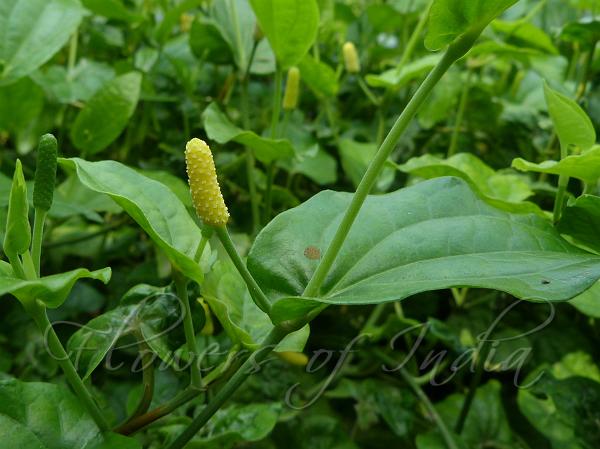|
| Long Pepper |
|

|

| File size | 430929 |
| Original date | 8/23/15 2:12 PM |
| Resolution | 1620 x 1215 |
| Flash | Flash did not fire, auto |
| Focal length | 4.5mm |
| Exposure time | 1/160s |
| Aperture | 4.0 |
| Focus Distance | |
| Metering Mode | Multi-segment |
| Camera make | Panasonic |
| Camera model | DMC-FZ40 |
| Sensor type | OneChipColorArea |
|
|
|
|
Photo: |
Botanical name: Piper longum Family: Piperaceae (Pepper family)
Long Pepper is a climber, of South Asian origin (Deccan peninsula),
cultivated for its fruit, which is usually dried and used as a spice and
seasoning. Long pepper is a close relative of the black pepper plant, and
has a similar, though generally hotter, taste. The word pepper itself is
derived from the Sanskrit word for long pepper, pippali. It is a slender,
aromatic, climber with perennial woody roots, creeping and jointed stems,
and fleshy fruits embedded in the spikes. Leaves are numerous, 6.3 to 9.0
cm, broadly ovate or oblong-oval, dark green and shining above, pale and
dull beneath. The older leaves are dentate, dark in color and heart shaped.
The younger leaf is ovate in shape and contains 5 veins on them. Flowers
are monoceous and male and female flowers are borne on different plants.
Male flower stalk is about 1 to 3 inch long and female flower stalk is ½ to
1 inch long. Fruit is long. When it ripes it attains red color and when it
dries it attains black color. It is one inch in diameter. The plant flowers
in rains and fruits in early winters.
Medicinal uses: Pippali is certainly one of the most widely used
of all Ayurvedic herbs. It is one of the best herbs for enhancing
digestion, assimilation and metabolism of the foods we eat. It is also
highly prized for its ability to enhance assimilation and potency of herbs
in a synergistic formula (this is called the Yogavahi effect).
Pippali is certainly one of the most widely used
of all Ayurvedic herbs. It is one of the best herbs for enhancing
digestion, assimilation and metabolism of the foods we eat. It is also
highly prized for its ability to enhance assimilation and potency of herbs
in a synergistic formula (this is called the Yogavahi effect).
Medicinal uses:
 Pippali is certainly one of the most widely used
of all Ayurvedic herbs. It is one of the best herbs for enhancing
digestion, assimilation and metabolism of the foods we eat. It is also
highly prized for its ability to enhance assimilation and potency of herbs
in a synergistic formula (this is called the Yogavahi effect).
Pippali is certainly one of the most widely used
of all Ayurvedic herbs. It is one of the best herbs for enhancing
digestion, assimilation and metabolism of the foods we eat. It is also
highly prized for its ability to enhance assimilation and potency of herbs
in a synergistic formula (this is called the Yogavahi effect). | Identification credit: Prashant More | Photographed in Lodhi Garden, Delhi & Jijamata Udyan, Mumbai. |
• Is this flower misidentified? If yes,